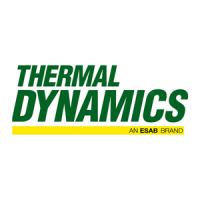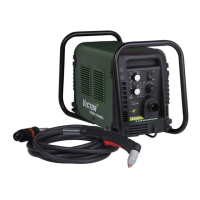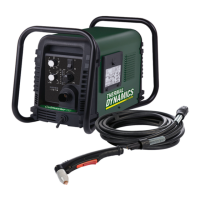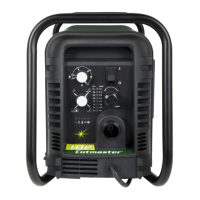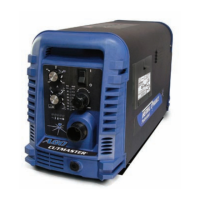INTRODUCTION & DESCRIPTION 10 Manual 0-2568
2.03 Specifications & Design
Features
The following apply to the Master Power Supply only:
1. Controls
ON/OFF Switch, Output Current Control, RUN/
SET/PURGE Switch, Secondary Gas Regulator,
Plasma Gas Regulator, Secondary Mode Switch, Sec-
ondary Water Flowmeter/Regulator, Optional Arc
Hour/Counter Meters
2. Control Indicators
LED Indicators:
AC , TEMP, GAS, DC, PILOT, COOLANT PRES, and
COOLANT COND
Gauges:
Secondary, Plasma, and Coolant Pressure Gauges
3. Input Power
Voltage Frequency Phase Amperage
200 50 or 60 Hz 3 98
220 50 or 60 Hz 3 89
230 50 or 60 Hz 3 85
380 50 or 60 Hz 3 51
415 50 or 60 Hz 3 47
460 50 or 60 Hz 3 42
500 50 or 60 Hz 3 40
575 50 or 60 Hz 3 34
NOTE
Refer to Appendix I for recommended input wir-
ing size, current ratings, and circuit protection re-
quirements.
Amps depends on input voltage (Refer to Appendix
I).
4. Output Power
Master Power Supply:
Continuously adjustable by potentiometer from 50
to 150 amps
With Slave Power Supply:
Continuously adjustable by potentiometer from
100 to 300 amps
5. Duty Cycle
100%
6. Pilot Modes
Auto-Restart, Pre-Flow Delay, "Recycle Required"
7. CNC Signals
Enable, Start/Stop, OK-To-Move, Pilot Sensing Relay
(PSR), Full CNC Available with Remote
8. Coolant Pressure
Internal Service-adjustable
130 psi (8.8 BAR) at zero flow
120 - 125 psi (8.2 - 8.5 BAR) at 0.6 gpm (2.6 lpm)
9. Coolant Flow Rate
0.5 gpm (2.2 lpm) with 150 feet of total torch and torch
leads at 70°F (21°C)
NOTE
The flow rate varies with lead length, torch con-
figuration, ambient temperature, amperage level,
etc.
10. Cooling Capacity
4,000 to 10,000 BTU
NOTE
Maximum value based on “free flow” condition.
11. Coolant Reservoir Capacity
2 gallons
Capable of handling a total of 150 feet of torch lead
length
12. Secondary Water
Tap water can be used as a secondary gas and must
be capable of delivering the following minimums:
• Water pressure of 50 psi (3.5 BAR)
• Flow of 8 gph (35.2 lph)
NOTES
Tap water should only be used as a secondary gas
on machine torches.
The tap water source does not need to be deionized,
but in water systems with extremely high mineral
content a water softener is recommended.
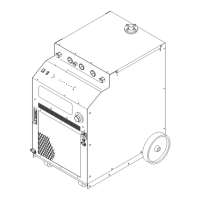
